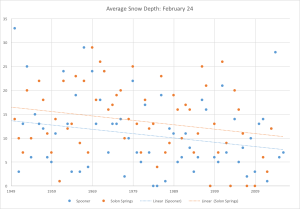The Birkie started in 1973. Since then, the race has been altered due to weather nine times. And with news that the lake is out, this year will mark the 10th. However, despite long-term declines in snowpack in northern Wisconsin, the race has just completed its longest streak of consecutive full Birkies in its history:
- 1973–1980: the race is held for the first eight times. The current trail was not laid out until 1975.
- 1981: the race is canceled. Elites and international racers ski laps of Mount Telemark. Other skiers return two weeks later when new snow falls.
- 1983–1985: three straight years where the race fails to reach Hayward, starting twice in Duffy’s Field and once in Rosie’s. (The race was being run northbound at that point.)
- 1991: The final Hayward-to-Cable race starts in Rosie’s Field, in a snowstorm.
- 1998: Race is shortened to OO (basically, race becomes the Kortelopet).
- 2000: Race canceled due to several feet of standing water at the base of some hills.
- 2002: Race shortened to Rosie’s Field
- 2007: Race shortened to OO, run as an “open track” event for non-elites. Several inches of snow fell in the evening, but it was not possible to push the race back.
- 2008–2016: the race is held on a full course for nine years straight, with nearly perfect conditions every year.
Looking at the longer-term trends, this (unfortunately) may be a hard record to crack again. Average snow depth has declined, over the past 70 years, at a rate of about one inch per decade, using snow depth data for Spooner and Solon Springs. Using just data from Spooner since 1973, the trend is flat, but this is rather selective. (I’ll have more of this analysis post-race.)
Let’s hope for as good a Birkie as we can get this year, and for better luck in 2018!


